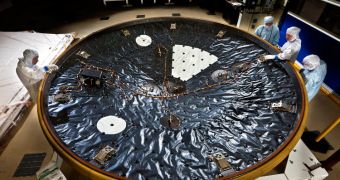The aeroshell and cruise stage that will go on the NASA Mars Science Laboratory (MSL) rover Curiosity have just been delivered at the Kennedy Space Center (KSC), in Florida, where the spacecraft is currently being assembled.
The aeroshell was constructed by Denver-based Lockheed Martin, following extremely precise specifications provided by the American space agency. Equally-precise fact sheets were sent to the NASA Jet Propulsion Laboratory (JPL), in Pasadena California, which built the cruise stage.
Officials say that the arrival of these critical components at the KSC marks an important milestone in getting Curiosity ready for launch later this year. The two components are indispensable to the success of the mission, the representatives add.
Once the MSL is integrated, the rover will be placed inside the aeroshell, and then covered with the cruise stage. This ensemble will protect the massive, 1-ton rover during the long journey it will make to the Red Planet. It is scheduled to reach its destination in 2012.
As this happens, the spacecraft will need to pass through the most critical moments of the mission, the atmospheric reentry and descent phases. At that time, it will be subjected to scorching temperatures caused by massive friction, and the aeroshell needs to withstand all these adversities.
The backshell of the MSL was shipped out from the March Air Reserve Base, in California, alongside the JPL-built cruise stage. The US Air Force C-17 Globemaster III transport plane then made a detour to the Buckley Air Force Base, near Denver.
Here, Lockheed Martin engineers loaded the heatshield onto the cargo plane, and sent it on its way. The C-17 arrived in Florida shortly after. The components now at the KSC will be joined by the actual rover and the descent stage this June.
Curiosity is currently being tested in the High Bay 1 facility at the JPL, which has just marked 50 years of continuous activity to support space exploration. Mission managers say that everything is looking good and on schedule for a launch later this year.
“Designing and building such a large and complex aeroshell was truly a challenge, but together with our partners, we have produced what we believe to be an amazing capsule,” expert Rich Hund says.
“We just finished the installation of the MEDLI package. Now we’re looking forward to seeing the data it will return as that knowledge will help determine how we design future Martian entry systems,” adds the official, who is the MSL program manager at Lockheed Martin Space Systems.
The nuclear-powered rover will conduct a host of exobiology and geology experiments on Mars. It is the largest spacecraft ever deployed on the surface of another planet, and is roughly the size of a Mini.
The mission will be managed by the JPL. Experts here also handle the Mars Exploration Rovers (MER) Spirit and Opportunity. The latter recently exceeded seven full years of operations on the Red Planet.

 14 DAY TRIAL //
14 DAY TRIAL //